I'm trying to apply a tessellation on the GPU for a simple Sphere. This tessellation is working perfectly for a simple plan, but it's not working for the sphere. Of course, I know the coordinates mapping aren't the same, I tried many ways to do it. For example, I tried to use the gl_TessCoord (x and y) in the tessellation Evaluation as longitude et latitude mapped into a plane. Then convert them to a spherical coordinates, but it 'really' didn't work.
For the tessellation control, I'm just splitting all patches into 2 for the outer and 2 as well for the inner level.
Here is my code to draw the sphere :
glBindVertexArray(vertexArrayObject);
glPatchParameteri(GL_PATCH_VERTICES, 4);
glBindBuffer(GL_ELEMENT_ARRAY_BUFFER, indicesBuffer);
glDrawElements(GL_PATCHES, indices.length, GL_UNSIGNED_INT, 0);
glBindVertexArray(0);
Here my current code in the tessellation Evaluation :
#version 430
layout(quads, fractional_even_spacing, ccw) in;
uniform mat4 u_projectionMatrix;
uniform mat4 u_viewMatrix;
uniform mat4 u_transformMatrix;
uniform float u_radius;
uniform vec3 u_cameraPosition;
void main(void){
vec4 position = gl_in[0].gl_Position;
position.xz += gl_TessCoord.xy * 2.0 - 1.0;
gl_Position = u_projectionMatrix * u_viewMatrix * u_transformMatrix * position;
}
Here are the indices :
int indPtr = 0;
for(int r=0; r< mRings-1; r++)
for(int s=0; s<mSectors-1; s++){
indices[indPtr++] = r * mSectors + s;
indices[indPtr++] = r * mSectors + (s+1);
indices[indPtr++] = (r+1) * mSectors + (s+1);
indices[indPtr++] = (r+1) * mSectors + s;
}
To draw the sphere, I followed this example : Creating a 3D sphere in Opengl using Visual C++ so all credits go to him (And thank you by the way !).
Here are two images showing the result :


If you have any hint that could help me solve this problem, It'd be really cool. Thank you. Note : If you need any other informations, please ask me and I'll post them.